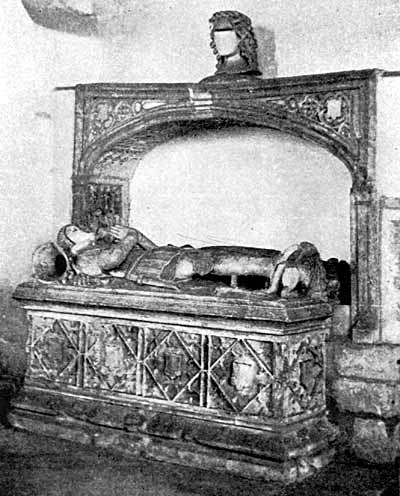MONUMENT No. 1.
Hic Jacent Rad’us Sacheverell Armiger nup Dñs de Ratcliff s : Sore, et Cecilia et Anna uxores ejus: quiquide Rad’us obiit xiiii die me’sis Augusti Aodni Mocccccxxxix et p’dicta Cecilia obiit xxvii die me’sis Junii A. dni W cccccxxviii, & p’dicta Anna migravit ab hoc saeculo. Quoru’ animabus propicietur deus. Amen. |
 |
| Radcliffe-on-Soar. Tomb of Radulphus Sacheverell (1539). |
This first of a series of tombs is placed beneath a canopy in the north wall of the chancel aisle to Cicely, the wife of Radulphus Sacheverell, who died 1528. This piece of workmanship is worthy of careful examination. Her husband who died 1539, left direction that he should be buried near his wife. It is unfortunate that his effigy has been placed in front of the effigy of his wife in such a way as to hide it partly from view.
I do not propose to enter minutely into the details of armour and costume, as these have been described by Mr. Fellows in his book; but I desire to draw attention to one or two points which may otherwise escape notice.
In my opinion this double tomb is the work of a celebrated local school of alabastermen, while at their very highest attainment. Notice especially the placid dignity of the features, the delicate chasing on the headdress of the lady, the abundance of jewelry, finger rings, etc., and the general atmosphere of spiritual repose; this is not strict portraiture but idealism. The charming little images in the tabernacle work of the canopy are now broken and defaced almost beyond recognition, but it is still possible to name the one at the lady’s head as her champion Knight St. George; the one at her feet as her protecting Saint, the Blessed Virgin. The Gothic lettering round the chamfer is worthy of the highest praise.
It is noticeable that no heraldic carving appears on either this tomb or the next one, the reason being that at that time it was the business of the stainer to provide the blazon; but the pigments he used have perished and Time has left all the escutcheons blank.
To give family distinction to the tomb however, a tilting helm has been placed on top of the canopy; but I think this may have been a later effort, for it is out of harmony and scale with the rest of the work. In any event it now falls short of its purpose because, like the helm beneath the Esquire’s head it is shorn of its most distinguishing feature,—the family crest, which was a wild goat passant.
If we compare the design of this tomb with the tomb of Sir Henry Pierrepont of Holme Pierrepont (1499), or the tomb of Sir John Shelley of Shelley (1487)—who were relations by marriage—we shall see that the likeness is sufficiently striking to warrant a suggestion that they all emanated from one and the same workshop. Excepting that Ralph Sacheverell wears the Lancastrian collar of SS., while Sir John Shelley wears the Yorkist collar, the effigies might be secretly transposed without anyone being the wiser. We know from records that the Strelleys had1 official dealings with the Nottingham alabastermen, and this seems to point to the source from which these sculptures came.
MONUMENT No. 2.
Here lyeth the bodyes of Henrie Sacheverell, esquier, and lucie, his wyf, daughter and heyre of John Pole, esquier; which henrie died the xxixth day of July, Anno dni 1558, and lucie died the xth day of ffebruarie 1554 upon whose Souls God have mercie. |

Beneath the arcade between the chancel and the north chapel lies Henry, son of Radulphus and his wife Lucy. According to his will he desired to be buried near to the wall on the south side of the chapel. There is a pathetic request in his will, that the beholders, and readers of the inscription on his tomb, may remember his soul and all christian souls, to pray to God for the same. (Torre M.S.).
While there is similarity in the workmanship and lettering when compared with the previous tomb, there is nevertheless a marked change in treatment, which I think is attributable to the influence exerted on memorial sculpture by Gerrard Jansen of Amsterdam, and his school of London craftsmen, who were engaged in setting up monuments for the aristocracy at Bottesford and elsewhere in the vicinity.
The squire, who was 49 years of age when he died, is here represented as in life with beard and moustache the lady’s dress displays the latest prevailing fashion, but in spite of farthingale, ruff, puffed sleeves, etc., all faithfully represented, the sculptor has managed to incorporate some very graceful folds in the drapery, and a play of fancy in the tying ribbons and other fal-lals of fashion.
On the sides of the tomb-chest their numerous progeny are represented as weepers, not as angels or bedesmen, but as natural offspring, each one displaying a ribbon scroll, and a shield, whereon their names and distinctions, together with a prayer sentence, were originally painted; but all the painted work is now obliterated. Four of the children—two on the west end, and one on either side—are represented in chrisom grave-clothes, to indicate that they died in infancy. From this point onward strict portraiture took the place of the beautiful sweetness depicted on the faces of earlier monuments.
(1) According to the Pipe Rolls, Sampson de Strelley was the Sheriff to whom King Edward III. entrusted the conveyance of a fine alabaster reredos from Nottingham to Windsor, in 1367.
